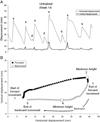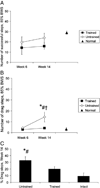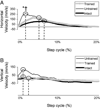Treadmill training enhances the recovery of normal stepping patterns in spinal cord contused rats
- PMID: 19111541
- PMCID: PMC3297429
- DOI: 10.1016/j.expneurol.2008.11.023
Treadmill training enhances the recovery of normal stepping patterns in spinal cord contused rats
Abstract
Treadmill training is known to improve stepping in complete spinal cord injured animals. Few studies have examined whether treadmill training also enhances locomotor recovery in animals following incomplete spinal cord injuries. In the present study, we compared locomotor recovery in trained and untrained rats that received a severe mid-thoracic contusion of the spinal cord. A robotic device was used to train and to test bipedal hindlimb stepping on a treadmill. Training was imposed for 8 weeks. The robotic device supported the weight of the rats and recorded ankle movements in the hindlimbs for movement analyses. Both the trained and untrained rats generated partial weight bearing hindlimb steps after the spinal cord contusion. Dragging during swing was more prevalent in the untrained rats than the trained rats. In addition, only the trained rats performed step cycle trajectories that were similar to normal step cycle trajectories in terms of the trajectory shape and movement velocity characteristics. In contrast, untrained rats executed step cycles that consisted of fast, kick-like movements during forward swing. These findings indicate that spinal cord contused rats can generate partial weight bearing stepping in the absence of treadmill training. The findings also suggest that the effect of treadmill training is to restore normal patterns of hindlimb movements following severe incomplete spinal cord injury in rats.
Figures






References
-
- Barbeau H, Julien C, Rossignol S. The effects of clonidine and yohimbine on locomotion and cutaneous reflexes in the adult chronic spinal cat. Brain Res. 1987;437:83–96. - PubMed
-
- Basso DM, Beattie MS, Bresnahan JC. Graded histological and locomotor outcomes after spinal cord contusion using the NYU weight-drop device versus transection. Exp. Neurol. 1996;139:244–256. - PubMed
-
- Behrman AK, Lawless-Dixon AR, Davis SB, Bowden MG, Nair P, Phadke C, Hannold EM, Plummer P, Harkema SJ. Locomotor training progression and outcomes after incomplete spinal cord injury. Phys. Ther. 2005;85:1356–1371. - PubMed
-
- Belanger M, Drew T, Provencher J, Rossignol S. A comparison of treadmill locomotion in adult cats before and after spinal transection. J. Neurophysiol. 1996;76:471–491. - PubMed
-
- Boyce VS, Tumolo MA, Fischer I, Murray M, Lemay MA. Neurotrophic factors promote and enhance locomotor recovery in untrained spinalized cats. J. Neurophysiol. 2007;98:1988–1996. - PubMed
Publication types
MeSH terms
Grants and funding
LinkOut - more resources
Full Text Sources
Medical

